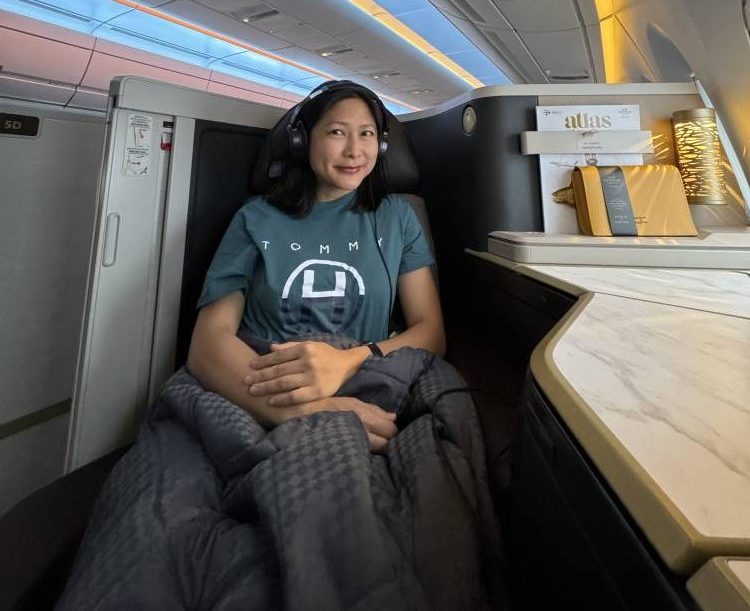Surviving the long-haul
April 10, 2024

Atty. Karen Jimeno
As I write this article from Argentina, I look back at how many hours I spent on a plane to get here. It took me around 35 hours to get from Manila to Buenos Aires, and I still have over two hours of flight time ahead of me to get to my friends’ wedding destination in Jujuy. At this point, I’ve seriously considered asking the bride and groom (a lovely couple who became my friends while studying at UC Berkeley) to give me an award for “Most Travelled Wedding Guest.”
During this long journey, I’ve thought about some hacks on how to survive a long-haul flight.
- Bring your own snacks. It’s difficult to determine when the flight attendants will be serving the meals. Meal distributions don’t often align with your meal time and you’ll have to wait over one hour after take-off for the food service to begin. Food service is also suspended in case there’s turbulence, which might further delay your meal. In other cases, the serving size of the meals may not be sufficient, the food might not be suitable for you or your dietary restrictions, or the gaps between meal services may be too long. Having your own snacks will ensure that you won’t starve during the flight.
- Bring toiletries in your hand carry. Toiletries in your hand carry (liquids must be below 100ml) are helpful to keep you sanitized and fresh. Going on a long-haul flight requires traveling for several hours or sleeping overnight on a plane, so you will also have to brush your teeth at some point or want to clean your face. Packing a moisturizer also helps because the air on the plane can dry your skin. The toiletries can also be useful if you have a lay-over and you wish to shower (there are usually shower facilities in the lounge or other airports have accessible showers for a fee).
- Have a charging cord in your seat and bring a battery pack. Ensure that your phone doesn’t run out of battery by the time you get to your destination. You will likely need your phone to get an Uber, check your messages, contact other people, or take photos. Charge your phone during your flight. Most airlines have charging stations in the passenger’s seats, but bring a battery pack in case your seat doesn’t have a charging station.
- Bring a refillable water bottle. Flights can be dehydrating, especially long-haul flights. Most airports have water stations located after the security-check where you can fill-up your own water bottle and not have to worry about discarding them prior to boarding the flight. Just like meals, it might be difficult to get enough water from the flight attendants (apart from not being served promptly, all types of services get suspended if there’s a turbulence). It’s better to have your own water supply next to you during the flight.
- Pack extra set of clothes. Because of the long travel time, you might feel grimy before reaching your destination. Having an extra set of clothes will enable you to change to a fresh set of clothes (midway if you’re doing a 12- or 15-hour straight flight) or at your lay-over airport. There’s a risk of missing your connecting flight due to unforeseen circumstances (such as delays in departing from your origin airport, airline mechanical issues, weather disturbances) and this might require you to stay overnight in a different country (this has happened to me several times). Pack an extra set of shirt, pants, underwear, socks, and overnight clothes in your hand carry—this way you can arrive fresh in your destination even if there’s no delay or you’ll be ready for unexpected delays.
- Prepare your own entertainment and/or bring your work. Airlines often have a suite of entertainment offerings (movies, TV shows, music, games), but there are some airlines that don’t provide these amenities. There’s nothing worse than having to stare-off into space than having to do this for several hours. Prepare ahead by bringing your own entertainment (a book to read, an iPad pre-loaded with movies or shows to watch) or bring your laptop so you can work during the flight. In some cases, airlines don’t provide individual screens but have an App that you need to download ahead of the flight so that you can access entertainment. Check ahead of your flight if you need to download an App.
- Pack medicines. It’s always a good idea to have medicines with you for any health issues. High altitude can exacerbate medical conditions or cause different types of discomfort (like nausea, dehydration, constipation), but the airline might not have the medicines you need. Make sure to put your vitamins/supplements and prescription medicines in your handcarry. Also pack medicines to address different types of symptoms. My medicine kit usually includes a paracetamol (for headaches, inflammation, muscle aches, or fever); loperamide or pepto-bismol (for diarrhea); a sachet of oral hydration salts (to prevent dehydration); and antacids (to relieve acidity).
- Check for wifi. Having wifi during a long flight can be useful to receive urgent messages or to send emails/documents (in case you’re working while traveling). Most airlines provide wifi access for free for a limited period of time, or for a fee. It might be worth paying that fee if it allows you to be connected or if it makes you more productive during the flight.
Traveling for several hours in a plane is never easy. But there are things we can do so that we not only survive, but “thrive”, in a long-haul flight.
Tags


















